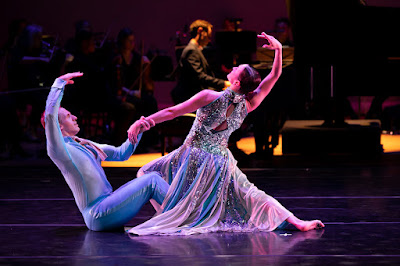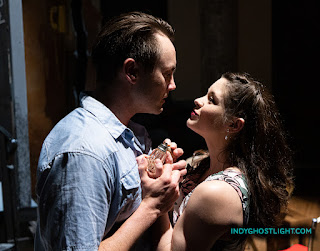Spring awakening: Return of collaboration between ICO and DK blossoms this weekend
 |
| Stuart Lewis and Paige Robinson in "Ravel Piano Concerto," with guest pianist Drew Petersen in background. |
When they are successful, showcases that bring two performing-arts groups together feel like a boon to the whole scene. So, without taking away from many other indications, "Music Moves" not only represents Dance Kaleidoscope and the Indianapolis Chamber Orchestra well; it also confirms the area's artistic re-emergence from the worst phases of the pandemic.
We had a live-streamed appetizer for the feast David Hochoy has made of Maurice Ravel's Piano Concerto in G major just over a year ago, when the first movement was presented. The world premiere of the complete work happened Saturday at Butler University's Schrott Center, the ICO's 475-seat home. The site has a great floor and a wide spectrum of lighting capability, showing off the dancers as well as the ingenuity and aptness of Laura E. Glover's designs.
At the back of the stage, the orchestra was not disadvantaged, as the hall's acoustics are splendid. An expanded company of assistants realized Barry Doss's variegated costume designs. Visually, Hochoy's choreography was linked to the music all the better. A stylistic magpie in this score, Ravel uses march music, jazz, modernist chic, and sentimental chanson with head-spinning clarity and pace.
The slow movement is a point of stillness whose simple melody never grows stale, especially when here it is part of a third collaborative link: the presence of 2017 American Pianists Association competition winner Drew Petersen as soloist throughout. His vigor in the outer movements helped hold the fast music together. As well as it was conducted by the ICO's Mathew Kraemer, the spread-out position of the ensemble made coordination challenging.
As Ravel makes his appropriation of various musical styles seem part of his signature, so does Hochoy's choreography. But the second movement was especially breathtaking because Hochoy found in it a superb scenario for a pas de deux. While the music seems to rest on one place — a place no listener ever wants to leave — the dancing uses that attractive focus to present exquisite pacing of a relationship that grows in intensity. The intensity is held back, even toward the end. But we can feel the interaction growing in intimacy and warmth. It was superbly danced Saturday by Paige Robinson (in a glittering costume that gave her diva-like presence) and Stuart Lewis, who is also the company's associate artistic director. (For a contrast visually and choreographically, another DK partnership, that of Emily Dyson and Manuel Valdes, comes to the fore in the third-movement ensemble setting of the music.)
Now in her seventh season with DK, Robinson has grown into a position extending the legacy of the troupe's female dancers who are also superb actors, building on a line that runs from Liberty Harris and Mariel Greenlee. Hochoy is good about not setting up stars among his dancers.
But some seem not merely responsive to functioning in the spotlight and embodying the choreographic vision, but projecting a character from within their mastery of the dance assignment as well. They have a gift for pathos, facial expressions that "tell" without mugging, something that moves you, almost as if the choreography were incidental. As seen Saturday, the Ravel second movement showed that Robinson is building upon a company tradition.
 |
| Light-hearted flair: Emily Dyson in "Brahms/Handel" |
The current troupe has the added richness of dancers who partner well. In the near term, the duo possibilities seem close to inexhaustible, if this show's finale, "Brahms/Haydn Variations," is indicative. What was even more impressive in that new work was a good distribution of comic gifts among the troupe. Insightfully, Hochoy has exploited the humor possibilities of Brahms' cunning variations on a theme that, it's turned out, is a chorale melody not composed by his great precursor Haydn. Brahms was among the most imaginative composers of variations ever, and his Opus 33a is firmly in the orchestral repertoire.
Stage comedy is a matter of turns, twists, and eventual resolution of human difficulties as the possibility of arriving at common ground is declared. That's what Brahms' sunny set of variations does as well, in abstract terms. Hochoy's inspiration is true here, and doesn't require a narrative, but simply a progression toward collective joy. There is a suggestion in Guy Clark's costumes that commedia dell'arte, a kind of comedy steeped in formulaic relationships, frames the action: the women in layered skirts that puff out wide at the hips evoke Colombine; the men's loose, long robes — trailing behind, lying open in front —hint at Pantalone.
There's bantering, nattering, coquetry, and romantic horseplay as successive variations pivot the theme this way and that. All this is portrayed in detail and with (secret word!) kaleidoscopic sass. As post-commedia operatic comedy traditionally makes explicit, the genuine happiness of all characters in their true selves comes through at the end. The spats and quibbles have vanished; the finale seems "a momentary stay against confusion" (in Robert Frost's phrase), and that's enough. It's all there in Hochoy's "Brahms/Haydn Variations," the sort of piece in which anyone can take heart.
 |
| Strike up the band: Cody Miley in "Candide" Overture |
As they had to do in the outer movements of the Ravel, the dancers displayed rhythmic and gestural acuity, this time within the span of four minutes or so. The music encourages an almost spasmodic response: I once saw the composer on tour with his beloved New York Philharmonic at the Meadow Brook Music Festival near Detroit. This was not conducting, and it only faintly resembled the spontaneous choreography Bernstein was known for in his heyday. The aging maestro sort of twitched and squirmed on the podium as the orchestra played with rote brilliance. It was idiomatic in the extreme, and perhaps Bernstein had a right to it. I bring it up here only to emphasize that this Overture to "Candide" submitted well to actual dancing.
The program opened with a more flowing and even more challenging new work by Hochoy. It was his setting of "Orawa" by Wojicheck Kilar, a piece and a composer introduced to Indianapolis audiences by Krzysztof Urbanski early in his tenure as music director of the Indianapolis Symphony Orchestra. The rapid stage crossings as well as the complicated poses and gestures occasionally relieved the side-to-side rush. But they never cut against the music's propulsiveness. Ending with a group shout, it was an effective curtain-raiser and will fill that function on Friday as DK opens the "Spring to Dance Festival" in St. Louis — a mark of distinction for a company that soon will celebrate its golden anniversary.
The ICO strings scintillated in supporting the troupe's exertions. Those got well-placed relief in the course of the program when the orchestra alone deftly performed one short, easy-breathing piece each by Arthur Honegger and G.F. Handel. Thus the dancers not only had the uplift of live accompaniment when they were active, but were able to catch a second breath or two and change costumes as the audience continued to be entertained by "Music Moves."
[Photos by Lora Olive]



Comments
Post a Comment